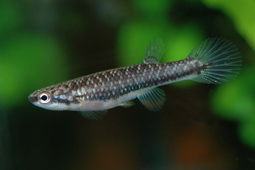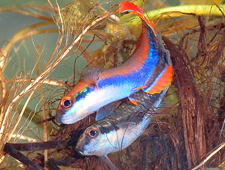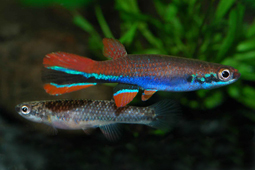History
Alternative name Laimosemion xiphidius.
Rivulus xiphidius , described from small creeks in French Guiana by the French ichthyologist Dr. Jean Huber. First discovered at Saut Maripa, close to the Oyapoque River, French Guiana, near the east- border with Brazil, by Mr. Blank in 1978. The species is wide spread in the lowlands of French Guiana and according to Huber possible also present more westerly near the west border with Surinam. This however need further confirmation.
The name xiphidius refers to the black mid- longitudinal band (along the sides) of the male and female that resembles a sword. (In Greek, idion= small and xiphos= sword) In the same paper Huber described also a new species, Rivulus amphoreus from Tafelberg, from the center of Surinam. This paper was his first scientific work on killies and was published for his Doctors-title. Many descriptions would follow. Dr. Jean H. Huber did become one of the most respected ichthyologists of its time, dedicating his whole active life as a scientist to the killifishes of the world.
The most important work he achieved is, I think, creating the most reliable Data-bank in his KilliData Online site, a source where a lot of the detailed information you find in here is coming from.
DNA sequenses show a strong relationship with Rivulus frenatus from the Essequibo system in the former Brittish Guyana.
Rivulus xiphidius is without doubt one of the most beautiful killies in the New World.
Reproduction
Keeping
and breeding is not easy and a good cover of the aquarium is necessary because
there ability to jump, even true the smallest opening, is unbelievable.
Eggs are 1.6 mm and amber colored. Stranded one by one in fine material
as plants or mop. Developing in 2 weeks, fry eat brine scrimp direct
after hatching. Sexulal active after 6 months, full adulthood in about 10 months. Lifespan up to 3,5 years in captivity.
The species is not very productive and only regulary water changes and enough small life food will bring them in a good breeding condition. One of the most succesful breeders of this small species is my friend Siegmund Sladkowsky. He add often some drops liquid vitamin to the artemia nauplien before he feeds them to his breeding pairs.
Perhaps we should think about this method if we want beautiful Rivulus xiphidius like the one on the image above. The eggs, with almost 2 mm in diameter, are relatively big for fishes of only 4 cm. maximum length and it is therefore no wonder they deliver only 2 to 5 of them in 24 hours. Only when separated for some time the first days it can be more than that. Best is to breed them pairwise, if food is always enough and some shelter is there the young's will raise in the breeding tank without predation of the parents. Putting 2 females to one male makes sometimes the second female eat the eggs of the spawning pair. (personal experience)
Variations
Map
Meristics
Max. size 4.0 cm.
Dorsal 9.0,
Anal 12.0,
D/A 8.0,
LL scale count (average) 31.0
Pre- dorsal length to % SL – 70.1 %
Depth to % SL – 19.0 %
Literature
Huber, J.H. 1979. A propos de quatre nouvelles Collections de Rivulus des Guyanes, avec Description de Rivulus xiphidius n.sp. et Rivulus amphoreus n.sp. Rev.fr.Aquariol, Herpet.,6:66, Fig.3.



